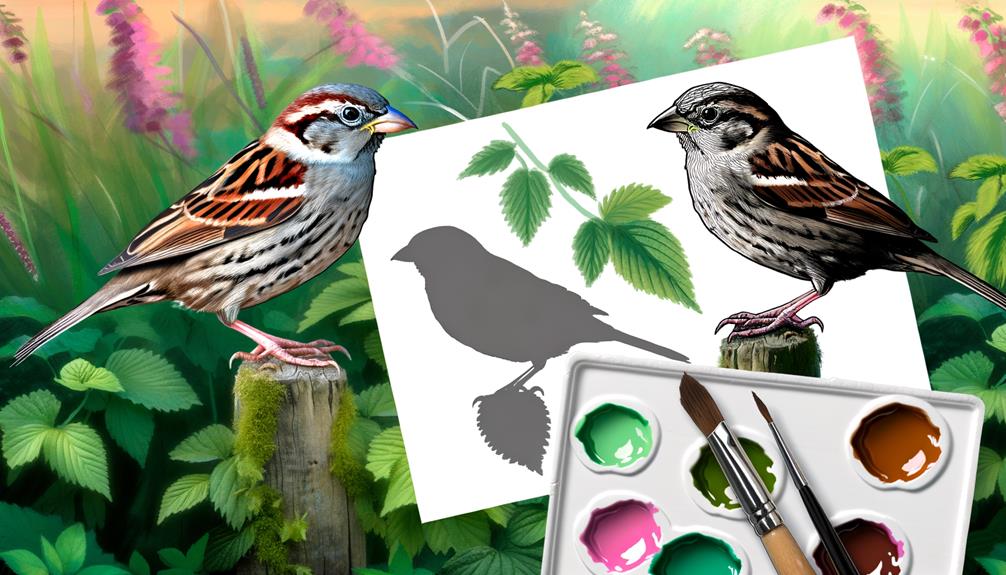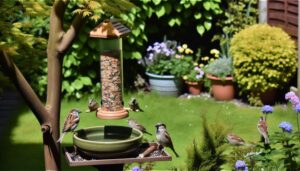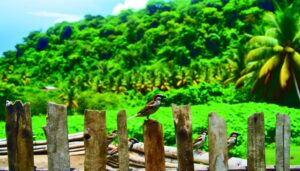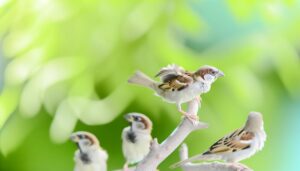7 Differences Between House Sparrow and Dunnock
House sparrows (Passer domesticus) and dunnocks (Prunella modularis) exhibit notable differences. House sparrows are bulkier with pronounced sexual dimorphism, possessing a thicker bill suited for granivorous diets.
In contrast, dunnocks are slender with homogenous plumage, favoring insectivorous feeding patterns. Sparrows display repetitive chirping calls, whereas dunnocks produce intricate songs.
Habitat preferences also diverge; sparrows thrive in urban environments building nests in human structures, while dunnocks prefer dense shrubbery and woodland edges, constructing well-concealed nests. Their social behaviors differ, with sparrows forming large flocks and dunnocks exhibiting more solitary or pair-based territoriality.
For a deeper comparative analysis, continue exploring.

Key Takeaways
- House sparrows exhibit pronounced sexual dimorphism, whereas dunnocks do not.
- Dunnocks have streaked brown and grey plumage, while house sparrows have thicker bills suited for eating grains.
- House sparrows are bulkier with a squared tail; dunnocks are slender with a rounded tail.
- House sparrows have simple chirping calls; dunnocks produce complex songs for mate attraction.
- House sparrows build nests in urban structures; dunnocks prefer concealed nests in dense shrubbery.
Physical Appearance
House sparrows (Passer domesticus) and dunnocks (Prunella modularis) exhibit distinct physical characteristics that facilitate their identification and differentiation in the field. The house sparrow, typically more robust, displays a striking sexual dimorphism. Males possess a distinctive black bib, white cheeks, and chestnut nape, while females and juveniles exhibit more muted brown and grey tones.
In contrast, the dunnock, often more slender, lacks such pronounced sexual dimorphism. Its plumage is uniformly streaked with brown and grey, giving it a more subdued and cryptic appearance. Additionally, the dunnock's finer bill is adapted for its insectivorous diet, whereas the house sparrow's thicker bill suits its granivorous feeding habits.
These differences in plumage and bill morphology are key to distinguishing these two species.
Size and Shape
When comparing the size and shape of the House Sparrow (Passer domesticus) and the Dunnock (Prunella modularis), notable differences emerge. The House Sparrow typically exhibits a bulkier body length ranging from 14 to 16 cm, whereas the Dunnock is more slender, measuring approximately 13 to 14.5 cm.
Additionally, the House Sparrow has a broader wingspan of 19 to 25 cm compared to the Dunnock's narrower wingspan of 19 to 21 cm, and their tail shapes also vary, with House Sparrows possessing a more squared tail and Dunnocks featuring a more rounded tail.
Body Length Comparison
Regarding body length, the House Sparrow (Passer domesticus) typically measures around 16 cm, while the Dunnock (Prunella modularis) is generally slightly smaller, averaging about 14 cm. This difference, although subtle, is significant in avian morphology. A comparative analysis reveals that these measurements contribute to their distinct ecological niches and behaviors. The House Sparrow's marginally greater length is complemented by a more robust body structure. Conversely, the Dunnock's smaller size is coupled with a more slender, delicate build, facilitating its foraging habits in dense undergrowth.
| Species | Average Body Length |
|---|---|
| House Sparrow | 16 cm |
| Dunnock | 14 cm |
This concise comparison underscores the nuanced variations in size and shape between these two passerine birds.
Wing Span Differences
The wingspans of the House Sparrow and the Dunnock exhibit notable differences. The House Sparrow's wings extend to approximately 21-25 cm, while the Dunnock's wingspan is typically narrower, ranging from 19-21 cm.
This variance in wingspan is reflective of their distinct ecological adaptations and flight patterns. The House Sparrow, with its broader wingspan, demonstrates increased maneuverability and sustained flight capabilities, essential for its urban and suburban habitats.
Conversely, the Dunnock's more constricted wingspan suggests an adaptation for shorter, more agile flights, suitable for dense underbrush environments. These morphological differences in wing size and shape not only influence their flight dynamics but also play a critical role in their respective foraging behaviors and predator evasion strategies.
Tail Shape Variations
Examining the tail morphology of the House Sparrow and the Dunnock reveals significant distinctions in both size and shape, which are indicative of their divergent ecological niches and behavioral adaptations.
The House Sparrow (Passer domesticus) exhibits a relatively short, squared tail, which facilitates agile, rapid flight and maneuverability within urban environments.
In contrast, the Dunnock (Prunella modularis) possesses a longer, more tapered tail, providing stability and precision during its characteristic low, fluttering flights through dense underbrush and hedgerows.
These morphological differences are not merely superficial; they reflect the species' respective foraging strategies and habitat preferences.
The House Sparrow's tail structure supports its opportunistic feeding habits, while the Dunnock's tail aids in navigating its more secluded, ground-level territories.
Coloration
The House Sparrow (Passer domesticus) shows a more evident dichotomy in plumage patterns, with males showcasing chestnut-brown and gray feathers contrasted by black bibs, whereas the Dunnock (Prunella modularis) presents a more uniform brown and gray streaking.
Wing markings also vary notably; House Sparrows feature distinct white wing bars, while Dunnocks have subtler, less noticeable streaks.
Concerning beak color, the House Sparrow's beak changes seasonally from yellow to black, while the Dunnock's remains a consistent dark brown, aiding in species identification.
Plumage Patterns
House Sparrows exhibit a more uniform, grayish-brown plumage with distinct black streaks on their backs, whereas Dunnocks display a subtler, mottled pattern of browns and grays with a more pronounced streaked appearance.
The House Sparrow's coloration is generally more consistent across its body, displaying a clearer demarcation between the gray crown and chestnut nape in males. In contrast, the Dunnock's plumage is characterized by a more intricate, variegated coloration, which aids in camouflage among underbrush.
The individual feathers of the Dunnock often show a combination of lighter and darker shades, contributing to a less uniform appearance. This differentiation in plumage patterns reflects their respective ecological niches and behaviors, with sparrows favoring open areas and dunnocks thriving in more concealed habitats.
Wing Markings
In addition to their distinct plumage patterns, wing markings further differentiate House Sparrows and Dunnocks. Sparrows exhibit bold, white wing bars that contrast sharply against their darker feathers. In contrast, Dunnocks display more subdued and less inconspicuous markings that blend seamlessly into their mottled brown and gray wings. This distinction is pivotal for ornithologists and birdwatchers alike as it aids in quick identification.
House Sparrow Wing Bars: Prominent white bars on the wings provide a stark contrast, aiding in immediate recognition.
Dunnock Wing Pattern: The mottled brown and gray wing coloration offers camouflage, making the markings less noticeable.
Comparative Analysis: House Sparrows' wing bars are an adaptation for visibility, whereas Dunnocks' muted markings enhance their inconspicuousness within their habitat.
Beak Color
Distinctive beak coloration provides another key differentiating feature between the House Sparrow and Dunnock, with the former exhibiting a robust, yellowish-brown bill, while the latter displays a more slender, dark grey beak.
The House Sparrow's beak is adapted for a diet that includes seeds and grains, necessitating a stronger, more durable structure. Conversely, the Dunnock's narrower, darker beak is better suited for foraging insects and other small invertebrates, reflecting its diet preferences.
This morphological distinction not only aids in species identification but also underscores their ecological niches.
Beak Differences
Examining the beak morphology of the House Sparrow (Passer domesticus) and the Dunnock (Prunella modularis) reveals significant differences in shape and functionality, which are adaptations to their respective feeding habits.
The House Sparrow's beak is short, conical, and robust, designed for cracking seeds and grains. In contrast, the Dunnock's beak is slender and pointed, ideal for foraging insects and small invertebrates.
Key differences in beak morphology include:
- Shape: The House Sparrow's beak is stout and conical, while the Dunnock's is slender and pointed.
- Size: The Sparrow's beak is relatively larger and more powerful.
- Functionality: Each beak type is a specialized tool, reflecting dietary preferences—granivorous for Sparrows and insectivorous for Dunnocks.
Vocalizations
The vocalizations of the House Sparrow (Passer domesticus) and the Dunnock (Prunella modularis) exhibit distinct acoustic characteristics that reflect their differing ecological niches and social behaviors.
House Sparrows produce a series of repetitive, chirping calls that serve primarily in communication within their gregarious flocks. These vocalizations are relatively simple, consisting of monotonous sequences that facilitate intra-species cohesion and territory defense.
In contrast, the Dunnock's song is more intricate, comprising a series of high-pitched, warbling notes that can vary widely in pitch and duration. This complexity aids in mate attraction and territorial advertisement, reflecting the species' more solitary and territorial nature.
Such differentiation in vocal patterns underscores the adaptive strategies each species employs within their respective environments.
Feeding Habits
Both the House Sparrow and the Dunnock exhibit divergent feeding habits, reflective of their ecological adaptations and dietary preferences. House Sparrows (Passer domesticus) are omnivorous, primarily consuming grains, seeds, and insects. In contrast, Dunnocks (Prunella modularis) adopt a more insectivorous diet, favoring small invertebrates such as beetles and spiders. These differences are notable in their foraging behaviors and habitat use.
- House Sparrow:
- Diet: Grains, seeds, insects
- Foraging: Ground and urban areas
- Adaptation: Utilizes human-provided food sources
- Dunnock:
- Diet: Insects, small invertebrates
- Foraging: Dense undergrowth
- Adaptation: Probes soil and leaf litter
This comparative analysis underscores the distinct ecological niches occupied by each species, driven by their specific dietary needs.
Nesting Behavior
Contrasting their nesting behaviors, House Sparrows typically construct bulky nests in cavities or structures provided by human environments, whereas Dunnocks prefer to build their well-concealed nests in dense shrubbery or low vegetation. House Sparrows often utilize man-made structures such as eaves, roofs, and even streetlights, demonstrating a high level of adaptability to urban settings. In contrast, Dunnocks opt for natural concealment provided by thick bushes and low-lying vegetation, emphasizing their preference for seclusion and protection. The following table summarizes these differences:
| Aspect | House Sparrows | Dunnocks |
|---|---|---|
| Nest Location | Cavities, human structures | Dense shrubbery, low vegetation |
| Nest Type | Bulky | Compact, well-concealed |
| Material Used | Grass, feathers, paper | Twigs, moss, leaves |
| Adaptability | High in urban environments | Prefers natural, less disturbed areas |
This table elucidates the distinct nesting preferences and strategies of these two avian species.
Habitat Preferences
House Sparrows exhibit a pronounced affinity for urban and suburban environments, often thriving in areas with abundant human activity and structural nesting opportunities. These areas provide several advantages:
- Food Sources: House Sparrows benefit from readily available food due to human activity, including waste and bird feeders.
- Shelter: Urban structures offer ample nesting sites, such as eaves, roofs, and crevices, ensuring protection from predators.
- Climate Moderation: Urban heat islands provide a relatively stable microclimate, particularly beneficial during harsher seasons.
In contrast, Dunnocks display a preference for more natural, less disturbed habitats. They are commonly found in dense shrubbery, woodland edges, and hedgerows. Their preference for these habitats allows them to exploit the cover and foraging opportunities provided by dense vegetation, which supports their insectivorous diet.
Social Behavior
Exhibiting marked differences in social behavior, House Sparrows are highly gregarious, often forming large flocks, while Dunnocks tend to be more solitary or found in loose, dispersed pairs.
House Sparrows' social structure is characterized by communal roosting and cooperative foraging, which enhances their survival in urban environments. Conversely, Dunnocks display a more complex social system, including polyandrous and polygynous mating behaviors, often resulting in territorial disputes.
These differences are influenced by their ecological niches, with House Sparrows thriving in densely populated human habitats, whereas Dunnocks frequent more secluded, diverse vegetative areas. The gregarious nature of House Sparrows contrasts sharply with the relatively reclusive behavior of Dunnocks, underscoring their distinct adaptive strategies and social dynamics.
Conclusion
To sum up, house sparrows and dunnocks show clear differences across various facets, such as physical features, vocalizations, and social interactions.
Particularly, house sparrows are more common, with a global population estimated to surpass 1.4 billion individuals, while dunnocks are less prevalent.
The house sparrow's sturdy, cone-shaped beak differs from the dunnock's slim, pointed beak, indicating their distinct feeding behaviors.
Grasping these distinctions offers valuable perspectives into the ecological roles filled by each species and their unique adaptive tactics.






